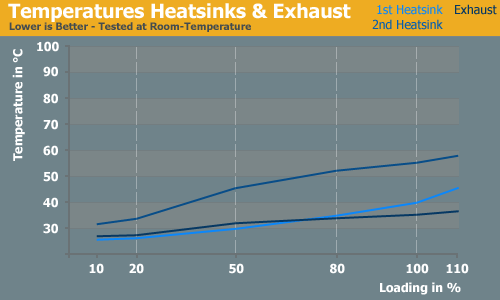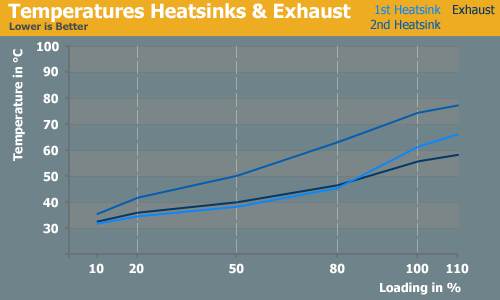400-450W PSU Roundup
by Christoph Katzer on November 6, 2007 4:00 AM EST- Posted in
- Cases/Cooling/PSUs
Thermaltake PFC, Temperature, Fan Speed, and Acoustics


Heatsink temperatures aren't as hot as what we saw with the Corsair and Antec units, but they still reach nearly 80°C during stress testing in our heat chamber. The heatsinks do seem to be able to dissipate a bit more heat into the airflow -- or more likely the large fan and increased airflow are simply doing a reasonable job of removing heat.


At normal room temperature, the fan turns at its minimum speed of 1100 RPM off to a load of around 220W. Maximum fan speed occurs at loads of roughly 80% and above. Thermaltake is definitely erring on the side of fan speed and airflow rather than keeping noise levels low, as the heat chamber reaches maximum fan speed at the 50% load. With a larger fan and relatively high RPMs, it's not too surprising that this becomes one of the noisier power supplies, particularly in the 500W and lower range.



Heatsink temperatures aren't as hot as what we saw with the Corsair and Antec units, but they still reach nearly 80°C during stress testing in our heat chamber. The heatsinks do seem to be able to dissipate a bit more heat into the airflow -- or more likely the large fan and increased airflow are simply doing a reasonable job of removing heat.


At normal room temperature, the fan turns at its minimum speed of 1100 RPM off to a load of around 220W. Maximum fan speed occurs at loads of roughly 80% and above. Thermaltake is definitely erring on the side of fan speed and airflow rather than keeping noise levels low, as the heat chamber reaches maximum fan speed at the 50% load. With a larger fan and relatively high RPMs, it's not too surprising that this becomes one of the noisier power supplies, particularly in the 500W and lower range.











37 Comments
View All Comments
Christoph Katzer - Tuesday, November 6, 2007 - link
Yep, otherwise it's just getting too long and I thought actually nobody is too interested in that analyses anyway. Let me work something out for the next ones...Ripple is also coming today, I updated the 1200-1300 roundup already.
Super Nade - Tuesday, November 6, 2007 - link
Good to know! I understand that it is going to take a considerable amount of work at the outset, to do a bit of design analysis, but once you have the popular topologies employed figured out it should be a lot less work.The length of the review is unimportant if it makes an interesting read. (Hypothetical example) Having 10 pages on the fans employed is going to be be boring. Since you have a wide audience with varying degree of technical appetite, the length of the review should not matter if the content is arranged appropriately.
Best wishes,
S-N
floffe - Tuesday, November 6, 2007 - link
When referring to the 8800GT article, it'd be nice to point out that those 327W from the wall was with SLI. A single card didn't get much over 200W, so even the Ultra should be able to run that, however horrible it otherwise is a a PSU.As for the market, I just wish someone would produce a high quality 300W modular PSU. That'd be plenty for my needs.
xsilver - Tuesday, November 6, 2007 - link
Would you be ok if they charged you the same as a 400w PSU? because for the manufacturers, they're not going to the trouble of making another PSU that costs them almost exactly the same to make.(its like asking for a car with only 15hp because thats all u need ;)
jonnyGURU - Tuesday, November 6, 2007 - link
Exactly. The cost difference at that level is rarely more than a $1. So if it costs me $30 to build a 400W, and $29 to build a 350W, etc. why would I bother?Souka - Wednesday, November 7, 2007 - link
maybe because some people "think" a 350w power supply consumes 50w less than a 400w power supply...:)
Hinkdog - Tuesday, July 21, 2020 - link
My 430 watt Antec Earthwatts that I bought in 2008 just failed. 12 years, pretty cool. Guess the 80mm fan didn't hurt its longevity. I know no one is going to read this in 2020 but wanted to post it anyway.